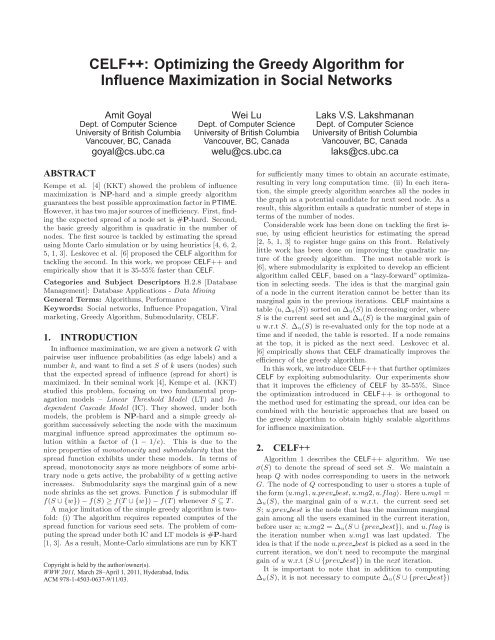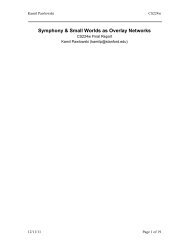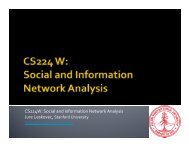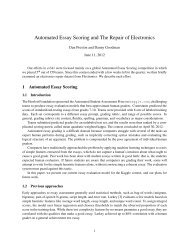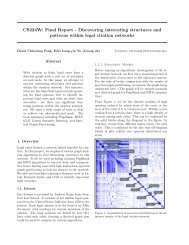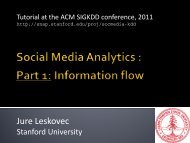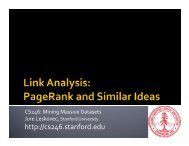CELF++: Optimizing the Greedy Algorithm for Influence ...
CELF++: Optimizing the Greedy Algorithm for Influence ...
CELF++: Optimizing the Greedy Algorithm for Influence ...
You also want an ePaper? Increase the reach of your titles
YUMPU automatically turns print PDFs into web optimized ePapers that Google loves.
ABSTRACT<br />
<strong>CELF++</strong>: <strong>Optimizing</strong> <strong>the</strong> <strong>Greedy</strong> <strong>Algorithm</strong> <strong>for</strong><br />
<strong>Influence</strong> Maximization in Social Networks<br />
Amit Goyal<br />
Dept. of Computer Science<br />
University of British Columbia<br />
Vancouver, BC, Canada<br />
goyal@cs.ubc.ca<br />
Kempe et al. [4] (KKT) showed <strong>the</strong> problem of influence<br />
maximization is NP-hard and a simple greedy algorithm<br />
guarantees<strong>the</strong>bestpossibleapproximationfactorinPTIME.<br />
However, it has two major sources of inefficiency. First, finding<br />
<strong>the</strong> expected spread of a node set is #P-hard. Second,<br />
<strong>the</strong> basic greedy algorithm is quadratic in <strong>the</strong> number of<br />
nodes. The first source is tackled by estimating <strong>the</strong> spread<br />
using Monte Carlo simulation or by using heuristics [4, 6, 2,<br />
5, 1, 3]. Leskovec et al. [6] proposed <strong>the</strong> CELF algorithm <strong>for</strong><br />
tackling <strong>the</strong> second. In this work, we propose <strong>CELF++</strong> and<br />
empirically show that it is 35-55% faster than CELF.<br />
Categories and Subject Descriptors H.2.8 [Database<br />
Management]: Database Applications - Data Mining<br />
General Terms: <strong>Algorithm</strong>s, Per<strong>for</strong>mance<br />
Keywords: Social networks, <strong>Influence</strong> Propagation, Viral<br />
marketing, <strong>Greedy</strong> <strong>Algorithm</strong>, Submodularity, CELF.<br />
1. INTRODUCTION<br />
In influence maximization, we are given a network G with<br />
pairwise user influence probabilities (as edge labels) and a<br />
number k, and want to find a set S of k users (nodes) such<br />
that <strong>the</strong> expected spread of influence (spread <strong>for</strong> short) is<br />
maximized. In <strong>the</strong>ir seminal work [4], Kempe et al. (KKT)<br />
studied this problem, focusing on two fundamental propagation<br />
models – Linear Threshold Model (LT) and Independent<br />
Cascade Model (IC). They showed, under both<br />
models, <strong>the</strong> problem is NP-hard and a simple greedy algorithm<br />
successively selecting <strong>the</strong> node with <strong>the</strong> maximum<br />
marginal influence spread approximates <strong>the</strong> optimum solution<br />
within a factor of (1 − 1/e). This is due to <strong>the</strong><br />
nice properties of monotonocity and submodularity that <strong>the</strong><br />
spread function exhibits under <strong>the</strong>se models. In terms of<br />
spread, monotonocity says as more neighbors of some arbitrary<br />
node u gets active, <strong>the</strong> probability of u getting active<br />
increases. Submodularity says <strong>the</strong> marginal gain of a new<br />
node shrinks as <strong>the</strong> set grows. Function f is submodular iff<br />
f(S ∪{w})−f(S) ≥ f(T ∪{w})−f(T) whenever S ⊆ T.<br />
A major limitation of <strong>the</strong> simple greedy algorithm is twofold:<br />
(i) The algorithm requires repeated computes of <strong>the</strong><br />
spread function <strong>for</strong> various seed sets. The problem of computing<br />
<strong>the</strong> spread under both IC and LT models is #P-hard<br />
[1, 3]. As a result, Monte-Carlo simulations are run by KKT<br />
Copyright is held by <strong>the</strong> author/owner(s).<br />
WWW 2011, March 28–April 1, 2011, Hyderabad, India.<br />
ACM 978-1-4503-0637-9/11/03.<br />
Wei Lu<br />
Dept. of Computer Science<br />
University of British Columbia<br />
Vancouver, BC, Canada<br />
welu@cs.ubc.ca<br />
Laks V.S. Lakshmanan<br />
Dept. of Computer Science<br />
University of British Columbia<br />
Vancouver, BC, Canada<br />
laks@cs.ubc.ca<br />
<strong>for</strong> sufficiently many times to obtain an accurate estimate,<br />
resulting in very long computation time. (ii) In each iteration,<br />
<strong>the</strong> simple greedy algorithm searches all <strong>the</strong> nodes in<br />
<strong>the</strong> graph as a potential candidate <strong>for</strong> next seed node. As a<br />
result, this algorithm entails a quadratic number of steps in<br />
terms of <strong>the</strong> number of nodes.<br />
Considerable work has been done on tackling <strong>the</strong> first issue,<br />
by using efficient heuristics <strong>for</strong> estimating <strong>the</strong> spread<br />
[2, 5, 1, 3] to register huge gains on this front. Relatively<br />
little work has been done on improving <strong>the</strong> quadratic nature<br />
of <strong>the</strong> greedy algorithm. The most notable work is<br />
[6], where submodularity is exploited to develop an efficient<br />
algorithm called CELF, based on a“lazy-<strong>for</strong>ward”optimization<br />
in selecting seeds. The idea is that <strong>the</strong> marginal gain<br />
of a node in <strong>the</strong> current iteration cannot be better than its<br />
marginal gain in <strong>the</strong> previous iterations. CELF maintains a<br />
table 〈u,∆u(S)〉 sorted on ∆u(S) in decreasing order, where<br />
S is <strong>the</strong> current seed set and ∆u(S) is <strong>the</strong> marginal gain of<br />
u w.r.t S. ∆u(S) is re-evaluated only <strong>for</strong> <strong>the</strong> top node at a<br />
time and if needed, <strong>the</strong> table is resorted. If a node remains<br />
at <strong>the</strong> top, it is picked as <strong>the</strong> next seed. Leskovec et al.<br />
[6] empirically shows that CELF dramatically improves <strong>the</strong><br />
efficiency of <strong>the</strong> greedy algorithm.<br />
Inthiswork, weintroduce<strong>CELF++</strong>thatfur<strong>the</strong>roptimizes<br />
CELF by exploiting submodularity. Our experiments show<br />
that it improves <strong>the</strong> efficiency of CELF by 35-55%. Since<br />
<strong>the</strong> optimization introduced in <strong>CELF++</strong> is orthogonal to<br />
<strong>the</strong> method used <strong>for</strong> estimating <strong>the</strong> spread, our idea can be<br />
combined with <strong>the</strong> heuristic approaches that are based on<br />
<strong>the</strong> greedy algorithm to obtain highly scalable algorithms<br />
<strong>for</strong> influence maximization.<br />
2. <strong>CELF++</strong><br />
<strong>Algorithm</strong> 1 describes <strong>the</strong> <strong>CELF++</strong> algorithm. We use<br />
σ(S) to denote <strong>the</strong> spread of seed set S. We maintain a<br />
heap Q with nodes corresponding to users in <strong>the</strong> network<br />
G. The node of Q corresponding to user u stores a tuple of<br />
<strong>the</strong><strong>for</strong>m〈u.mg1,u.prev best,u.mg2,u.flag〉. Hereu.mg1 =<br />
∆u(S), <strong>the</strong> marginal gain of u w.r.t. <strong>the</strong> current seed set<br />
S; u.prev best is <strong>the</strong> node that has <strong>the</strong> maximum marginal<br />
gain among all <strong>the</strong> users examined in <strong>the</strong> current iteration,<br />
be<strong>for</strong>e user u; u.mg2 = ∆u(S ∪{prev best}), and u.flag is<br />
<strong>the</strong> iteration number when u.mg1 was last updated. The<br />
idea is that if <strong>the</strong> node u.prev best is picked as a seed in <strong>the</strong><br />
current iteration, we don’t need to recompute <strong>the</strong> marginal<br />
gain of u w.r.t (S ∪{prev best}) in <strong>the</strong> next iteration.<br />
It is important to note that in addition to computing<br />
∆u(S), it is not necessary to compute ∆u(S ∪{prev best})
from scratch. More precisely, <strong>the</strong> algorithm can be implemented<br />
in an efficient manner such that both ∆u(S) and<br />
∆u(S ∪{prev best}) are evaluated simultaneously in a single<br />
iteration of Monte Carlo simulation (which typically contains<br />
10,000 runs). In that sense, <strong>the</strong> extra overhead is relatively<br />
insignificant compared to <strong>the</strong> huge runtime gains we<br />
can achieve, as we will show from our experiments.<br />
<strong>Algorithm</strong> 1 <strong>Greedy</strong> <strong>CELF++</strong><br />
Require: G,k<br />
Ensure: seed set S<br />
1: S ← ∅; Q ← ∅; last seed = null; cur best = null.<br />
2: <strong>for</strong> each u ∈ V do<br />
3: u.mg1 = σ({u}); u.prev best = cur best; u.mg2 =<br />
σ({u,cur best}); u.flag = 0.<br />
4: Add u to Q. Update cur best based on mg1.<br />
5: while |S| < k do<br />
6: u = top (root) element in Q.<br />
7: if u.flag == |S| <strong>the</strong>n<br />
8: S ← S ∪{u};Q ← Q−{u};last seed = u.<br />
9: continue;<br />
10: else if u.prev best == last seed <strong>the</strong>n<br />
11: u.mg1 = u.mg2.<br />
12: else<br />
13: u.mg1 = ∆u(S); u.prev best = cur best; u.mg2 =<br />
∆u(S ∪{cur best}).<br />
14: u.flag = |S|; Update cur best.<br />
15: Reinsert u into Q and heapify.<br />
In addition to <strong>the</strong> data structure Q, <strong>the</strong> algorithm uses<br />
<strong>the</strong> variables S to denote <strong>the</strong> current seed set, last seed to<br />
track <strong>the</strong> id of last seed user picked by <strong>the</strong> algorithm, and<br />
cur best to track <strong>the</strong> user having <strong>the</strong> maximum marginal<br />
gainw.r.t. S overallusersexaminedin<strong>the</strong>currentiteration.<br />
The algorithm starts by building <strong>the</strong> heap Q initially (lines<br />
2-4). Then, it continues to select seeds until <strong>the</strong> budget k is<br />
exhausted. As in CELF, we look at <strong>the</strong> root element u of Q<br />
and if u.flag is equal to <strong>the</strong> size of <strong>the</strong> seed set, we pick u as<br />
<strong>the</strong> seed as this indicates that u.mg1 is actually ∆u(S) (lines<br />
6-9). The optimization of <strong>CELF++</strong> comes from lines 10-11<br />
where we update u.mg1 without recomputing <strong>the</strong> marginal<br />
gain. Clearly, this can be done since u.mg2 has already been<br />
computed efficiently w.r.t. <strong>the</strong> last seed node picked. If none<br />
of <strong>the</strong> above cases applies, we recompute <strong>the</strong> marginal gain<br />
of u (line 12-13).<br />
3. EXPERIMENTS<br />
We use two real world data sets consisting of academic<br />
collaboration networks: NetHEPT and NetPHY, both extracted<br />
from arXiv 1 . NetHEPT is taken from <strong>the</strong>“High Energy<br />
Physics – Theory”section and has 15K nodes and 32K<br />
unique edges. NetPHY is taken from <strong>the</strong> full“Physics”section<br />
and has 37K nodes and 174K unique edges. The graphs<br />
are undirected, however we make <strong>the</strong>m directed by taking<br />
<strong>for</strong> each edge <strong>the</strong> arcs in both <strong>the</strong> directions. We consider<br />
<strong>the</strong> IC model and assign <strong>the</strong> influence probability to arcs<br />
using two different settings, following previous works (e.g.,<br />
see [4, 2, 1]). In <strong>the</strong> first setting, <strong>for</strong> an arc (v,u) we set<br />
<strong>the</strong> influence probability as pv,u = 1/din(u), where din is<br />
<strong>the</strong> in-degree of <strong>the</strong> node u. In <strong>the</strong> second setting, we assign<br />
a uni<strong>for</strong>m probability of 0.1 to all arcs. In all <strong>the</strong> experiments,<br />
we run 10,000 Monte Carlo simulations to estimate<br />
<strong>the</strong> spread.<br />
1 http://www.arXiv.org<br />
Dataset<br />
Running time (min)<br />
CELF <strong>CELF++</strong> Gain<br />
Avg. # node lookups<br />
CELF <strong>CELF++</strong> Gain<br />
Hept WC 245 159 35% 18.7 13.4 28.3%<br />
Hept IC 5269 2439 53.7% 190.5 101.5 46.7%<br />
Phy WC 1241.6 667.7 46.2% 18.6 15.2 18.3%<br />
Table 1: Comparison between CELF and <strong>CELF++</strong>.<br />
Number of seeds = 100.<br />
The results are shown in Table 1. We use WC (weighted<br />
cascade) to refer to <strong>the</strong> case when <strong>the</strong> probabilities are<br />
non-uni<strong>for</strong>m and IC <strong>for</strong> <strong>the</strong> uni<strong>for</strong>m probability 0.1 setting.<br />
We only show <strong>the</strong> results corresponding to NetHEPT WC,<br />
NetHEPT IC, and NetPHY WC <strong>for</strong> brevity. The results <strong>for</strong><br />
NetPHY IC are similar. In <strong>the</strong>se settings, we found that<br />
computing u.mg2 <strong>for</strong> all nodes in <strong>the</strong> first iteration results in<br />
large overhead. So, we apply <strong>CELF++</strong> starting from <strong>the</strong> second<br />
iteration. Notice that <strong>the</strong> optimization behind <strong>CELF++</strong><br />
can be applied starting from any iteration. As can be seen,<br />
<strong>CELF++</strong> is significantly faster than CELF. This is due to<br />
<strong>the</strong> fact that <strong>the</strong> average number of“spread computations”<br />
per iteration is significantly lower. Since we apply <strong>the</strong> optimization<br />
starting from <strong>the</strong> second iteration, we report <strong>the</strong><br />
average number of nodes examined starting from <strong>the</strong> third<br />
iteration.<br />
Memory Consumption: Although <strong>CELF++</strong> maintains<br />
a larger data structure to store <strong>the</strong> look-ahead marginal<br />
gains (u.mg2) of each node, <strong>the</strong> increase of <strong>the</strong> memory consumption<br />
is insignificant. For instance, CELF consumes 21.9<br />
MB <strong>for</strong> NetHEPT and 39.7 MB <strong>for</strong> NetPHY, while <strong>CELF++</strong><br />
uses 22.4 MB and 41.2 MB respectively.<br />
4. CONCLUSIONS<br />
In this work, we presented <strong>CELF++</strong>, a highly optimized<br />
approachbasedon<strong>the</strong>CELFalgorithm[6]inordertofur<strong>the</strong>r<br />
improve <strong>the</strong> naive greedy algorithm <strong>for</strong> influence maximization<br />
in social networks [4]. <strong>CELF++</strong> exploits <strong>the</strong> property<br />
of submodularity of <strong>the</strong> spread function <strong>for</strong> influence propagation<br />
models (e.g., Linear Threshold Model and Independent<br />
Cascade Model) to avoid unnecessary re-computations<br />
of marginal gains incurred by CELF. Our empirical studies<br />
on real world social network datasets show that <strong>CELF++</strong><br />
works effectively and efficiently, resulting in significant improvements<br />
in terms of both running time and <strong>the</strong> average<br />
number of node look-ups.<br />
5. REFERENCES<br />
[1] W. Chen, C. Wang, and Y. Wang. Scalable influence<br />
maximization <strong>for</strong> prevalent viral marketing in large-scale<br />
social networks. In KDD 2010.<br />
[2] W. Chen, Y. Wang, and S. Yang. Efficient influence<br />
maximization in social networks. In KDD 2009.<br />
[3] W. Chen, Y. Yuan, and L. Zhang. Scalable influence<br />
maximization in social networks under <strong>the</strong> linear threshold<br />
model. In ICDM 2010.<br />
[4] D. Kempe, J. Kleinberg, and É. Tardos. Maximizing <strong>the</strong><br />
spread of influence through a social network. In KDD 2003.<br />
[5] M. Kimura and K. Saito. Tractable models <strong>for</strong> in<strong>for</strong>mation<br />
diffusion in social networks. In PKDD 2006.<br />
[6] J. Leskovec et al. Cost-effective outbreak detection in<br />
networks. In KDD 2007.


